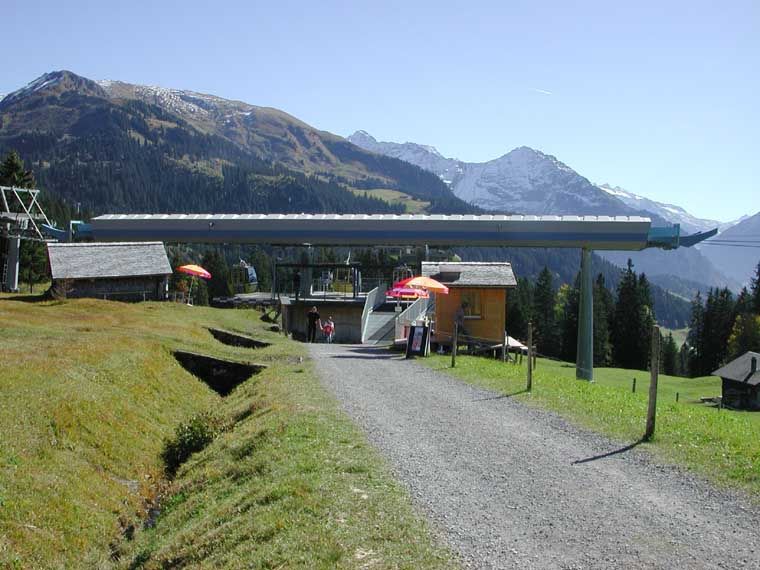
A gondola lift servicing Hasliberg, Switzerland includes a mid station (seen above) with only 40 second dwell times. Image via Remontees-Mecaniques.
Sometimes life is just weird.
Last week the issue of dwell times pretty much dominated conversation and discussion around these parts at The Gondola Project (here and then here). The main issue was whether or not dwell times were a real problem and if so, what solutions could be engineered.
And then – by some bizarre fluke – this past weekend I visited a mountain in the Berner Oberland region of Central Switzerland. That mountain, Hasliberg, happens to be serviced by a gondola lift that includes a mid station with dwell times of only 40 seconds (trust me, I timed it). That the station is so incredibly slim profile only heightens its importance.
A few caveats:
- The top speed of this gondola is only 18 km/hr.
- Vehicles can only carry 6 passengers.
- System capacity is only 1,200 pphpd.
- There is no major turn co-located within the station.
Increasing any of these metrics could, potentially, nullify the possibility of such short dwell times. Nevertheless, the Hasliberg gondola demonstrates that short dwell times are not just possible in theory, but demonstrable in practice as well.
Built by Garaventa in 1996, it bears a striking resemblance to the Grindelwald-First gondola -another major find in the Berner Oberland region of Central Switzerland. That system is one of the only lifts I know of that includes high-speed turns.
Combined, the Hasliberg and Grindelwald-First gondolas demonstrate that there is a whole sub-sector of cable tactics and technologies which are little known or understood. How these tactics are discovered and then usefully integrated into urban gondola transit systems will largely determine cable’s success into the future.
They also increasingly demonstrate the importance of our learning from existing ski resort systems as a means to improve upon existing urban systems.

16 Comments
@Steven
Did you get any video?
@ Sean,
Sadly no. I wasn’t going there explicitly to check it out. I just stumbled upon it. I should take a pocket-cam with me everywhere from now on I guess.
Mobile phones and digi cams also do the job 😉
Ah the Bernese Oberland. I remember catching an aerial gondola to get back up the hill to Murren after I somehow wandered down to some village, maybe Gimmelwald. The mountain gondolas don’t strike me as being used by crowds of people and would only have a few hundred passengers a day. It was only a small number of Swiss Francs to ride up. Presumably it is economic, or maybe it is subsidised to some extent. Which begs the question, how small a number of passengers can an aerial gondola serve economically? If it is down to a couple hundred people, then why don’t we see aerial gondolas used in lots more places?
@ Matt T,
“how small a number of passengers can an aerial gondola serve economically?”
This I think is a fantastic question and one worthy of exploring further.
The ropeway Lauterbrunnen-Muerren connects Muerren (1,650 m above sea level, a village without cars) with the railway station of Lauterbrunnen, to transport primarily the 450 inhabitants/pupils of Muerren, goods, letter post and agricultural products and secondarily tourists (2,000 guest beds). The village is popular through the summer and winter; it features a view of the three towering mountains: Eiger, Mönch, and Jungfrau.
You can find also a ropeway Muerren-Grimmelwals for the same types of purposes.
I believe, the personal is working there round the year and it doesn’t matter if one day 100 Persons are transported and another day 2,000. At the year end they must have a positive effect on profit. At urban ropeways in towns and cities too. The Metro-Cable of Medellin investment was amortised about 8 months, I heard. (not be checked ! ) Public transport and its prices often has social benefits, but every investment must be profitable.
Sorry, Grimmelwald
Matt, have a look here:
https://www.gondolaproject.com/2011/02/15/video-gondola-transit-in-medellin/
I looked for a new ropeway project:
http://www.seilbahn.net/snn/bericht.php?wert=450&wert1=23&zurueck=2
(in German language)
Planai ‘Golden Jet’
route length: 2,430 m (up to 640 m)
cabins: 8 persons
capacity: 2,408 persons/hour
towers: 15
cabins: 87
drive: 1,090 kW
speed: 6.00 m/s
costs of all (ropeway, towers, buildings…): Euro 11.000,000.–
financing costs ???
amortisation ???
operation runs 20-30 years, then it is antiquated technology (the material can run 50-100 years too);
How many passengers you need a year, a month, a day?
…and similar plants need 30 employees;
about energy consumption I have only an average value:
approximate value of 5.3 kWh / person and skiing day
(average of switzerland, includes perhaps energy for snow making machines)
So, you can calculate the amortisation approximately §:o)
@Matt. Have you got my email last week?
Anyway, those factors Guenther summarized surely are more precise than the upcoming theory, but you could make it even easier: watch cableway-installations like on EXPO’s or the one in Koblenz, watch the costs, be aware of the towers, technology and station used and the length of the over-all-runtime and of course the price for a ticket. Count it down to the expected passengers, count the ticket money up to the investment and see how many people will have to ride that thing… it’ll give you a clear perspective. 🙂
“@Matt. Have you got my email last week?”
No
At Zuerich, Switzerland, a ropeway will connect the zoo with a railway station.
1500 persons/hour and direction
2 km (7 min); 160 m upward;
17.000,000.- Franken
source: newspaper ‘Tagesanzeiger’, Zuerich, 19/02/2011
Ropeway Zoo Zuerich:
length: 2’145,9 m
upward: 159,5 m
towers: 10
8 pers./gondola
max. 5 m/s
gondola interval minimum: 19,2 s
gondola interval: 96 m
travel time: 7,2 min.
51 gondolas
For your calculation you find an interesting report about
“Estimated amount of emission reductions” of Metrocable de Medellin here:
http://cdm.unfccc.int/filestorage/NVOQ2UM4DH93P65XS0TWJLFEAYB8IG/PDD.pdf?t=OG18MTMwMTI3MDk4Mi42Mg==|0oBGprxwwzRKjuqXqTSpY-nM-BA=
EU Carbon rises to highest price in two years as German reactors are shut, they are now (2011-03-15) at € 17,21 / t CO2.